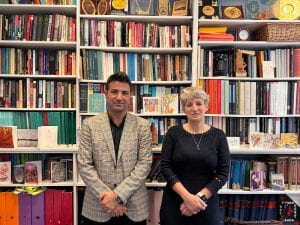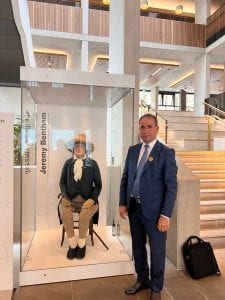Oral History in Iraq
By Zainab, on 25 August 2025
We talk to Alaa Alameri, Professor of Modern and Contemporary History at the College of Arts at Mustansiriyah University. Alaa held a Nahrein – BISI Visiting Scholarship at Newcastle University. His project is titled Oral History in Iraq and is under the supervision of Professor Graham Smith.

Prof Alaa at Newcastle University
Tell us a little about yourself.
I am Alaa Al-Ameri, Professor of Modern and Contemporary History at the College of Arts, Mustansiriyah University, and a researcher specializing in modern and contemporary Japanese history, Japanese education, historical research methodologies, and the philosophy of history. I earned my PhD in 2014 from the University of Baghdad, with a dissertation on The Role of the Liberal Democratic Party in Japan’s Reconstruction (1955–1973). I have held research fellowships at the University of Tokyo (2012), Chiba University (2022), and Newcastle University (2025).
I also held several academic and administrative positions, including serving multiple terms as Head of the History Department at the College of Arts, Mustansiriyah University. I was also the Rapporteur of the Committee for Updating History Curricula at the Iraqi Ministry of Higher Education and Scientific Research. Additionally and played a key role in coordinating and implementing academic agreements between Mustansiriyah University and Chiba University, Newcastle University, and the French Institute for the Near East.
I participated in numerous international conferences and has published research in his areas of expertise. I have also contributed to organising international academic workshops, including the Iraqi-Japanese International Conference, now in its fifteenth edition, and a workshop on oral history and its integration into Iraqi academia, alongside conferences on national identity and modern historical methodologies.
Beyond academia, I believe that scholars in the humanities should have practical laboratories to apply their ideas for the benefit of society. Based on this vision, I founded Al-Qiyam Private Schools in Baghdad in 2015, an educational initiative adopting Japan’s Tokkatsu system, which emphasises character building and life skills development. I see these schools as more than just an educational institution; they serve as a practical space for implementing his ideas on educational reform, bridging academic research with real-world application to drive sustainable change.
I have received numerous awards and honours in recognition of my academic and educational contributions. I continue to develop educational and research projects that enhance the role of knowledge in shaping society.

Tell us about your project.
Mainstream academic historical studies have long relied almost exclusively on written documents, often sidelining or undervaluing oral narratives, which are typically viewed as unreliable or lacking objectivity. This approach becomes especially problematic in contexts marked by prolonged conflict and weak institutional documentation, as is the case in Iraq—a country that, for decades, has experienced wars, rapid political shifts, sanctions, civil unrest, terrorism, and a severe institutional vacuum in formal documentation and archival systems. As a result, significant gaps persist in the national historical record, with no comprehensive archive capturing the lived experiences of individuals and communities in real-time.
In such settings, oral memory emerges as an indispensable source for understanding Iraq’s social, cultural, and political history, especially when it comes to marginalised groups: women, peasants, workers, ethnic and religious minorities, and victims of violence—many of whom remain excluded from official historical accounts. The absence of their voices threatens to erase vital layers of Iraq’s living history.
This guide adopts a methodological vision that seeks to restore the value of oral history as a scientific tool for documenting collective memory and to bridge the gap between academia and society. It advocates for the integration of oral history into university institutions by developing a comprehensive academic curriculum, training researchers in oral history methods, and establishing oral archives that preserve Iraq’s diverse historical experience before it is lost to time or the passing of those who lived it. In doing so, the guide contributes to reconstructing national memory and promoting epistemic justice in the narration of Iraq’s contemporary history.
How was your Visiting Scholarship experience in the UK?
It was an essential and distinguished academic and scientific journey that significantly contributed to strengthening and developing the relationship between Mustansiriyah University and Newcastle University, resulting in the creation of a new educational curriculum and its introduction into the Iraqi academy for the first time.
What were the main benefits of your scholarship?
The preparation of an academic guide and curriculum to be adopted in history departments within Iraqi academia. In title (Oral History in Iraq: A Methodological and Practical Guide for Academic Research and University Training).
What was the main highlight of your scholarship?
It was exceptional and fruitful in every aspect, particularly in terms of the academic experience I gained from a prestigious university, which I will certainly carry forward to my current university.
What were the main things you learnt from your Host Institution?
A robust spirit of support and scientific collaboration from colleagues, combined with the development of a global research approach. I have gained enough experience to employ the oral history method in academic research and to train students in applying this new research approach.
How has the scholarship helped you in your work in Iraq?
The fellowship plays a crucial role in enhancing research and historical writing techniques in Iraq, benefiting individuals and leading to the creation of a guide for academic research in oral history for the entire Iraqi academic community.
What will you do to continue your research in Iraq?
The subject has been introduced as a course for master’s students and will be offered as a joint programme between Al-Mustansiriyah University and Newcastle University. It has also been included as a topic within the historical research methodology curriculum for undergraduate students. Furthermore, an international symposium on the subject will be held on 16 October at Newcastle University.

 Close
Close




















 A seminar was organized by Endangered Archaeology in the Middle East and North Africa EAMENA, which was based at the University of Oxford. I described the role of intangible cultural heritage in the revival of tangible heritage and he considered the historic City of Najaf as a case study, where the presentation title was: “Najaf, Iraq: Developing a Sustainable Approach to Threatened Heritage”.
A seminar was organized by Endangered Archaeology in the Middle East and North Africa EAMENA, which was based at the University of Oxford. I described the role of intangible cultural heritage in the revival of tangible heritage and he considered the historic City of Najaf as a case study, where the presentation title was: “Najaf, Iraq: Developing a Sustainable Approach to Threatened Heritage”.




